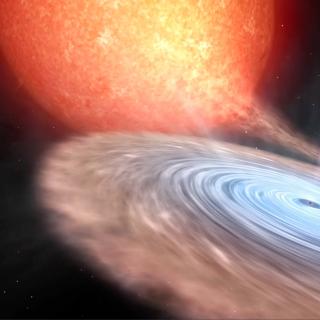Bibcode
Nieder, L.; Clark, C. J.; Bassa, C. G.; Wu, J.; Singh, A.; Donner, J. Y.; Allen, B.; Breton, R. P.; Dhillon, V. S.; Eggenstein, H. -B.; Hessels, J. W. T.; Kennedy, M. R.; Kerr, M.; Littlefair, S.; Marsh, T. R.; Mata Sánchez, D.; Papa, M. A.; Ray, P. S.; Steltner, B.; Verbiest, J. P. W.
Bibliographical reference
The Astrophysical Journal
Advertised on:
9
2019
Journal
Citations
34
Refereed citations
33
Description
The Low-Frequency Array radio telescope discovered the 707 Hz binary millisecond pulsar (MSP) J0952-0607 in a targeted radio pulsation search of an unidentified Fermi gamma-ray source. This source shows a weak energy flux of F γ = 2.6 × 10-12 erg cm-2 s-1 in the energy range between 100 MeV and 100 GeV. Here we report the detection of pulsed gamma-ray emission from PSR J0952-0607 in a very sensitive gamma-ray pulsation search. The pulsar’s rotational, binary, and astrometric properties are measured over 7 years of Fermi-Large Area Telescope data. For this we take into account the uncertainty on the shape of the gamma-ray pulse profile. We present an updated radio-timing solution now spanning more than 2 years and show results from optical modeling of the black-widow-type companion based on new multiband photometric data taken with HiPERCAM on the Gran Telescopio Canarias on La Palma and ULTRACAM on the New Technology Telescope at ESO La Silla (based on observations collected at the European Southern Observatory, Chile; programme 0101.D-0925, PI: Clark, C. J.). PSR J0952-0607 is now the fastest-spinning pulsar for which the intrinsic spin-down rate has been reliably constrained ({\dot{P}}int}≲ 4.6× {10}-21 {{s}} {{{s}}}-1). The inferred surface magnetic field strength of {B}surf}≲ 8.2× {10}7 {{G}} is among the 10 lowest of all known pulsars. This discovery is another example of an extremely fast spinning black-widow pulsar hiding within an unidentified Fermi gamma-ray source. In the future such systems might help to pin down the maximum spin frequency and the minimum surface magnetic field strength of MSPs.
Related projects

Black holes, neutron stars, white dwarfs and their local environment
Accreting black-holes and neutron stars in X-ray binaries provide an ideal laboratory for exploring the physics of compact objects, yielding not only confirmation of the existence of stellar mass black holes via dynamical mass measurements, but also the best opportunity for probing high-gravity environments and the physics of accretion; the most
Montserrat
Armas Padilla